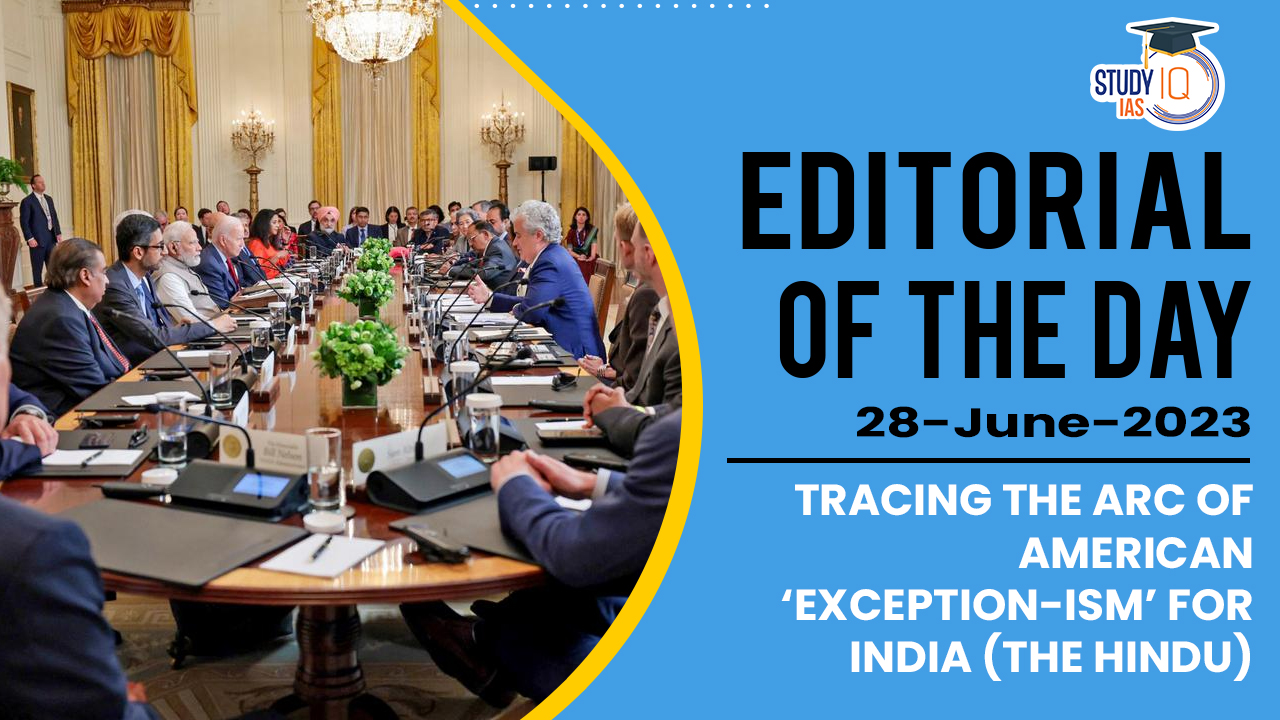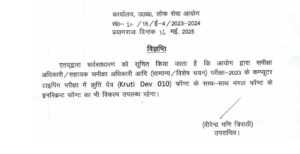Context: The article discusses the growing bilateral relationship between the United States and India over the past 25 years. It highlights the significant progress made in the relationship, which is attributed to various exceptions and concessions made by the United States for India. These exceptions include the nuclear waiver granted to India in the 2000s and the recent transfer of technology in 2023. The article mentions that the relationship between both sides had a low point 25 years ago when the U.S. imposed sanctions on both India and Pakistan after they conducted nuclear weapon tests. However, since then, the relationship has steadily improved year by year, with the efforts of five American Presidents and three Indian Prime Ministers. The article identifies different phases of the relationship, such as the Clinton-Vajpayee era that focused on summit-level diplomacy, the Manmohan-Bush and Manmohan-Obama period that emphasised nuclear diplomacy, and the Modi-Obama and Modi-Trump period that worked on trade and military diplomacy. Overall, the article highlights the U.S.’s shift from the belief in “American exceptionalism” to a more pragmatic approach of making exceptions specifically for India. This change in approach is identified as a significant factor in the strengthening of the bilateral relationship between the two nations.
Decoding the Editorial
The article is emphasising the significant growth and improvement in the relationship between India and the United States.
The Recent State Visit:
- The recent visit of the Indian Prime Minister to Washington and his meetings with the US President are catalysts for further progress in the relationship.
- Technology diplomacy, particularly the promise of Transfer of Technology (ToT) from the U.S. through the Memorandum of Understanding between General Electric Aerospace and Hindustan Aeronautics Limited (HAL) to produce fighter jet engines for the Indian Air Force, is an important aspect of the growing ties.
- India now focuses on the evolving relationship, and hence lays emphasis on moving beyond historical hesitations and Cold War-era foreign policy approaches towards the United States.
- The shift in the U.S.’s stance from “American exceptionalism” to a more pragmatic approach of making exceptions specifically for India is a crucial factor in the significant advancements and surges in the relationship.
The Civil Nuclear Deal:
- There have been a series of exceptions and waivers granted by the United States to India in the field of civil nuclear cooperation.
- Just six months after imposing sanctions on India and Pakistan in 1998, President Clinton signed a waiver to those sanctions.
- The Bush administration further pushed for civil nuclear exemptions, resulting in the India-U.S. Joint Statement in 2005.
- These exceptions and waivers included the Non-Proliferation Act waiver, the Henry Hyde Act, and the 123 Agreement with India.
- Additionally, India received an India-specific exemption at the Nuclear Suppliers Group in 2008.
- During President Obama’s visit in 2010, there was progress in implementing these waivers, leading to further exceptions for India on export controls and high technology trade and transfers under the U.S. Export Administration Regulations (EAR) and International Traffic in Arms Regulations (ITAR).
- Despite India not being a party to the Nuclear Non-Proliferation Treaty (NPT) and the Comprehensive Nuclear-Test-Ban Treaty, the United States made these exceptions specifically for India.
- The waivers were not extended to other non-NPT countries such as Pakistan. This indicates a shift in the United States’ alignment in South Asia and signifies the importance placed on the U.S.-India relationship.
The Russian Angle:
The article highlights the Russian angle in the exceptions and waivers granted by the United States to India.
- In the past decade, the U.S. waivers have primarily been related to regulations dealing with Russia, such as the Countering America’s Adversaries Through Sanctions Act (CAATSA) of 2017.
- The Trump administration avoided sanctioning India for its purchase of the Russian S-400 missile system, while imposing sanctions on Turkey and China for similar purchases.
- In 2022, the U.S. House of Representatives passed the “[Ro] Khanna amendment,” which, if made law, would exempt India entirely from CAATSA sanctions.
- Despite the Russian war in Ukraine, the U.S. has ruled out secondary sanctions against India for its significant oil imports from Russia and defence engagement with Russia.
- This is considered an exception, especially since President Biden ordered sanctions on German entities for their involvement in the Nord Stream 2 pipeline.
- Additionally, there were exemptions granted to India under the International Religious Freedom Act.
- Despite recommendations to place India on a list of “Countries of Particular Concern” by the U.S. Commission on International Religious Freedom, the State Department has not complied.
- This implies that the United States has made various exceptions and waivers for India, despite its close ties with Russia and Iran, both considered adversaries of the U.S.
- These exceptions have been made without India being required to sever ties with these adversaries, withdraw from groupings such as the Shanghai Cooperation Organisation or BRICS, or commit to joining U.S. military operations against them.
- All these exceptions have been granted to India even though there have been limited commercial contracts for U.S. companies in sectors such as nuclear power plants, fighter jets, and weapons systems.
Why does the US favour India?
The article provides a perspective on why the United States has institutionalised a broad-based waiver policy for India over the past 25 years. It highlights several reasons behind this policy.
- Firstly, the promise of ties with India, being the world’s most populous inclusive and pluralistic democracy with a record in non-proliferation, is seen as an attractive factor. The U.S. considers expressing concerns about issues such as non-proliferation or authoritarianism to be unproductive, particularly when dealing with large countries like China and India.
- Secondly, India’s economic market and its position as a significant military buyer make it appealing to the United States. The potential for economic engagement and defence partnerships contributes to the waiver policy.
- Thirdly, India’s geographical location in Asia and its boundary disputes with China present an opportunity for the U.S. to have a reliable partner in countering China’s influence. India’s regional significance adds value to the U.S.-India relationship.
- Fourthly, the Indian-American diaspora is recognized as a significant factor. The community, known for its professionalism, law-abiding nature, prosperity, and support for stronger India-U.S. ties, is acknowledged by both sides.
Challenges in the Waiver Policy:
There are several challenges in the India-U.S. relationship regarding the waiver policy:
- Reversibility of Exceptions: One challenge is that the exceptions made for India can be reversed at any time. This means that the favourable treatment and waivers granted to India by the U.S. could be withdrawn or altered in the future, which creates uncertainty and potential instability in the relationship.
- One-Directional Relationship: The relationship between India and the U.S. is portrayed as largely one-directional. The U.S. provides more in terms of investment, technology transfer, and hardware. This suggests an imbalance in the relationship, where India is perceived as primarily benefiting from the exceptions made by the U.S.
- Uncertain Pace and Timing of Cooperation: The pace and timing of cooperation in critical areas such as high-tech co-production, clean energy, semiconductors, and artificial intelligence are seen as uncertain and determined by the U.S. This implies that India’s progress in these areas is contingent upon the U.S.’s decision-making and willingness to cooperate, which may not align with India’s own priorities and goals.
- Geopolitical Context: The geopolitical context of the U.S.-India relationship, driven by countering China and reigning in Russia, is described as primarily an American construct. This means that India’s perspective and approach to geopolitical issues may not fully align with those of the U.S., suggesting potential differences in strategic priorities and interests.


 UPPSC RO ARO Exam Date 2025 Out: Typing ...
UPPSC RO ARO Exam Date 2025 Out: Typing ...
 Maharashtra Bill to Curb Urban Naxalism,...
Maharashtra Bill to Curb Urban Naxalism,...
 International Maize and Wheat Improvemen...
International Maize and Wheat Improvemen...





















